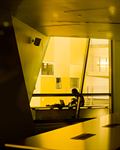
UC Merced announces the U.S. Green Building Council has awarded platinum LEED certification to the Social Sciences and Management Building.
Every building project on campus has already or is expected to attain LEED (Leadership in Energy and Environmental Design) certification, meaning it meets or exceeds standards for sustainability.
UC Merced is being built green from the ground up, with a deep commitment to sustainability in all forms, from landscaping and water to recycling and energy efficiency.
The campus has its Triple Net Zero Commitment to consume zero net energy, produce zero landfill waste and produce zero net greenhouse gas emissions, and sustainability is a watchword in all the campus does.
“It has been an excellent collaborative effort of the entire Design and Construction team in partnership with Facilities Management to achieve this recognition,” said campus architect Tom Lollini. “This is our second platinum certification, and lines up subsequent projects to achieve similar results through the USGBC Multi-Building Pilot program, in which UC Merced has served as a national leader.”
 The campus LEED scorecard so far is one silver certification, eight gold certifications and two platinum certifications, with five platinum certifications pending. The campus completed the Student Activities and Athletics Center last fall, and has several new buildings opening over the next two to three years: the Half Dome student housing, which opens later this month; the Student Services Building; Science and Engineering Building 2; and the Classroom and Academic Office Building – all of which are expected to achieve LEED platinum status.
The campus LEED scorecard so far is one silver certification, eight gold certifications and two platinum certifications, with five platinum certifications pending. The campus completed the Student Activities and Athletics Center last fall, and has several new buildings opening over the next two to three years: the Half Dome student housing, which opens later this month; the Student Services Building; Science and Engineering Building 2; and the Classroom and Academic Office Building – all of which are expected to achieve LEED platinum status.
Attaining LEED platinum certification, the highest ranking in the four-tiered system, means rigorous attention to sustainable design criteria and a thorough documentation and review process.
Lollini said the work has been a team effort. UC Merced’s continuing success in attaining exceptional LEED outcomes is a collaborative effort with campus facilities staff, and a tribute to the leadership of Design & Construction LEED Director Mark Maxwell, who has developed innovative and effective strategies to ensure campus buildings consistently exceed sustainability goals.
UC Merced’s sustainability efforts aren’t limited to construction, either. They include:
- involving students in sustainability projects, from water-saving competitions in the residence halls to their daily participation in recycling and composting programs;
- energy efficiency in all buildings;
- diverting as much from area landfills as possible by recycling. For example, since the campus began construction, it has generated 9,444 tons of construction waste, and diverted 7,760 tons — 82 percent.
- production of more than 2 million kilowatt hours of electricity by the campus’ solar farm – equaling 14 percent of campus usage;
- reduction of food packaging waste through the reusable containers;
- reuse of cleansing chemicals in science labs
These efforts are good for the environment and the campus budget.
“From a life-cycle perspective, each of these projects is achieving or exceeding the maximum energy and water savings credits available within the LEED accreditation program, saving the campus significant operating costs over the expected life of these buildings.” Lollini said. “Think $2 million per year in energy savings for the current building inventory times the 50- to 100-year life of these buildings, and it adds up to a very sound business decision.”






